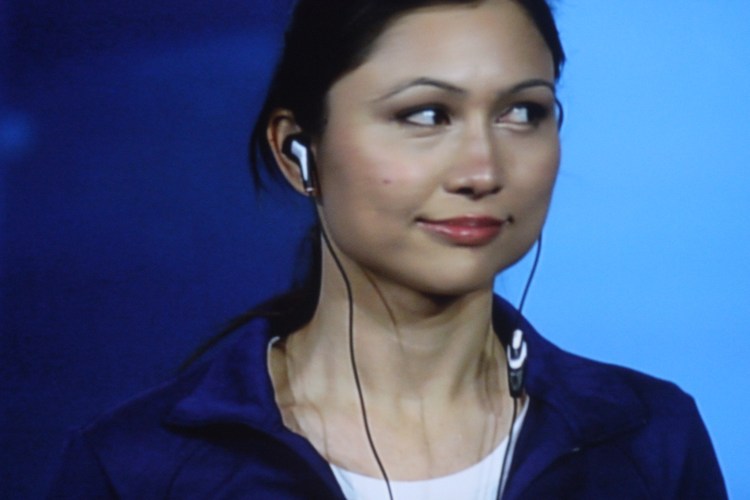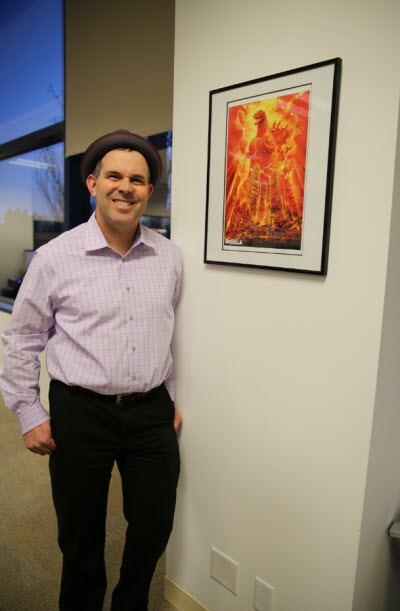The internet of things is going to take Intel into the brave new world of fashion design. And jewelry design. And baby monitor design.
So be it, says Steven Holmes, the vice president and general manager of Intel’s New Devices Group. Holmes and his team at the world’s biggest chip maker designed a bunch of the newfangled gadgets that Intel CEO Brian Krzanich showed off at his first keynote speech at the 2014 International CES in Las Vegas last week.
Krzanich said that everything is becoming smart. That means fashion, jewelry, wearables, and ordinary things will have sensors, connectivity, and processors built into them. Holmes’ job is to envision and design such gadgets in partnership with fashion designers at Opening Ceremony and retailer Barneys New York.
Before joining Intel in mid-2012, Holmes was a product director at Nike, where he helped launched devices like the Nike+Fuel Band. He also worked at Palm and Apple. That may seem like a long way from chip design, but Intel knows that it has both envision and design future gadgets so that its chips can be used in those gadgets. And with the internet of things, the competition is wide open.
We caught up with Holmes at the recent CES show. Here’s our edited transcript.
VentureBeat: Are you involved in fashion?
Steven Holmes: My team worked on all of the wearables that Brian Krzanich showed. We’re going to be very involved with the collaboration between the fashion industry and Intel.
VB: It looked like you’ve been working on those a long time. Has this all been under way for a while?
Holmes: Not really. The New Devices Group was established about six months ago. After the initial rush to get the team established, we’ve really only had five months to get together all the things we showed on stage, from coming up with the ideas to having working products.
VB: What’s the intention there? Is it to show what’s possible, or to have an Intel product line, or to find partners to bring this together?
Holmes: The intent is to find partners for these devices. Intel brings together technology and product integration. We have a lot of innovation to provide. But we don’t have retail channels. We’ve been very successful by enabling partners. That’s the intent in this space as well.
VB: Is this another case where you have to reach beyond being a component maker, to do much more around a product?
Holmes: That’s true. Especially in the case of wearables and other cutting-edge products. The future is for us to define. We can have an active role in doing that. Intel has a tremendous depth of bench as far as engineering. The company has experience with building great software. We have experienced teams that are looking at the future of devices. We want that future to happen faster, and the best way to do it is to chip in and do some of the heavy lifting ourselves.
VB: Did you already have fashion designers on board?
Holmes: We have some industrial designers. [laughs] I don’t know that we would have anybody who counts as a fashion designer. That’s why we’re excited about this collaboration. There’s a different mindset that comes with designing items of desire that the fashion industry creates, versus pieces of technology in the industry that we’re used to.
VB: Is there another model that you see out there, something that Intel has done before, as far as the right way to bring this vision to market?
Holmes: Yeah. Even if you look at the two-in-ones, for instance, as a very modest example, that was an initiative that was largely driven from inside Intel. We had a number of trusted partners who worked with us on it. Intel does have a great track record of helping to pioneer some of these next-generation devices, but we do it with partners who are important along the way.
If you look at the laptop, that was another one, and the success of wi-fi and Centrino. Intel led the initiative, but the entire industry – and especially the consumer – benefited from it.
VB: How did you choose some of these categories? Some of them seem like there’s already competition out there. It almost seems like that part of the industry is already doing its job. LG’s showed things like the earbuds that can detect your heartbeat. Smart watches are getting to be more common, especially at the show here.
Holmes: Those are great examples. You could argue the same thing about the laptop, really. People already had desktops. Why did you need a laptop? The difference, for me, with the earbuds—I’m sure the LG product is a fine product. But the Intel device doesn’t require a battery. It doesn’t require a pairing. It requires just that you plug the headphones into your phone. That simplifies people’s lives. It’s an innovation that reduces some of the friction for people to use technology in a way that integrates naturally into what they already do.
VB: How does that work? Do you get power going in through the headphone wire?
Holmes: We’re using the existing wires inside the headphone jack. We’re pulling power from the audio into the electronics inside the headphone. There aren’t any additional wires necessary from the audio side, so it works with any existing phone.
VB: You don’t need that much power to do it, then?
Holmes: That was the challenging part. There are going to continue to be interesting opportunities to advance the state of the art. We’ll see improvements due to Moore’s Law and reductions in power usage and the convergence of various connectivity technologies.
This is an exciting time, especially in the wearable space. A lot of things you might never have considered using before, because they’re too bulky or too expensive or too inconvenient, the technology integration is becoming good enough that you can start to move these things from science fiction to fact.
VB: Are there some examples where you’re taking advantage of the other things Brian announced – the Quark, or Edison?
Holmes: Absolutely. I can’t make any other disclosures beyond what we’ve shown so far, but I can say that we have a lot of other things in flight right now. Quark and Edison are a big part of what the New Devices Group will be working on.
VB: Is that role almost more like a temporary role, until the industry gets on a better footing here? Or is this like the Xbox model, where at some point Intel becomes a system seller?
Holmes: I can’t speculate on what the future holds. I will say that the New Devices Group is only around looking at the next devices that are going to impact people’s lives after phones and tablets. Wearable is clearly one piece of that strategy and direction, but there’s a whole world of other possibilities that we’re exploring as well.
VB: This is all very new. It seems like the company has taken a large chunk of resources and pointed it in a new direction in a very short time. Is that how you’d describe it?
Holmes: I think this is an area of passion for Brian, and the board as well. There’s a commitment to being a leader in the space. We’re very pleased at the support. The most important support is the expectation that we move quickly and deliver, because that’s motivating everybody on the team. We’ve accomplished a great deal in a short time and I don’t expect the pace to slow down.




